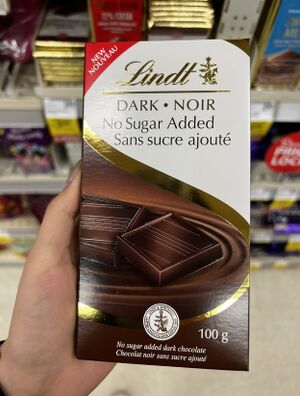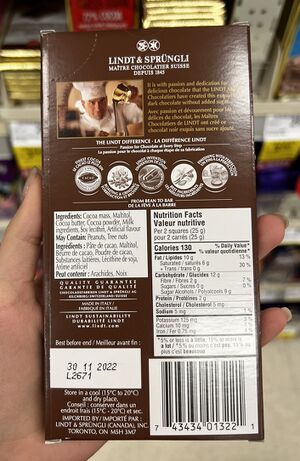Course:FNH200/Assignments/2022/Lindt Chocolate - Dark vs No Sugar Added
Introduction
Lindt is a Swiss chocolate and confectionery company that produces a wide variety of sweets[1]. Their products are readily found all over the world, including Canada. Dark chocolate is enjoyed by those who want the perfect balance of sweetness and bitterness.
The two products we have chosen to compare are Lindt Excellence 70% Cacao Dark Chocolate and Lindt No Sugar Added Dark Chocolate.




Ingredient lists
1. Ingredients
| Lindt Regular Dark Chocolate | Lindt No Sugar Added Dark Chocolate |
|---|---|
|
|
2. Substitutes and Additives
| Lindt Regular Dark Chocolate | Lindt No Sugar Added Dark Chocolate | |
|---|---|---|
| Sugar substitutes | None | Maltitol |
| Fat substitutes | None | None |
| Additives | None | Soy Lecithin |
3. Roles of Substitutes & Additives
Lindt 70% Dark Chocolate
Sugar Substitutes: None
Fat Substitutes: None
Additives: None
Lindt No Sugar Added Dark Chocolate
Sugar Substitutes:
- Maltitol - A type of sugar-alcohol produced by hydrogenation of maltose with properties nearly identical to sucrose, except for browning and its reduced sweetness (~75-90% of the sweetness of sucrose). [2] Sugar-alcohols including maltitol are known to be non-cariogenic and have a reduced effect on raising blood glucose levels as compared to sucrose due to its slower rate of absorption[2], which may be suitable for diabetics who still want to enjoy sweets. It also contains half as many calories compared to sucrose. Maltitol is often used in baked goods, chewing gum, sugar-free chocolates, hard candies, and ice cream.[3]
Fat Substitutes: None
Additives:
- Soy lecithin - A phospholipid derived from raw soybeans that is often used as an emulsifier or lubricant when added to food. Also has antioxidant properties and is used as a flavour protector. [4] In this case, soy lecithin is used to lower the viscosity of chocolate such that the chocolate is more easily tempered and molded.[5] It also improves sugar crystallization and lengthens the shelf-life of the product. [5]
4. Compare and contrast the lists of the two products and explain differences
Similar Ingredients in both types of chocolate
- Cocoa mass- an ingredient used to intensify the flavour of chocolate[6]
- Cocoa butter- an ingredient used to help with the texture of chocolate[7]
Different ingredients in Lindt Regular Dark Chocolate
- Sugar- used to sweeten the chocolate
- Vanilla bean- intensifies the flavour of vanilla in the chocolate
- Lindt Regular Dark Chocolate has many less ingredients which include sugars considered to be natural sugars and is intensified with on added flavour which is vanilla bean.
Different ingredients in Lindt No Sugar Added Dark Chocolate
- Maltitol- a sugar substitue[8]
- Soy lecithin- a naturally occurring emulsifier[9]
- Cocoa powder- intensifies the flavours within the chocolate
- Artificial flavour- intensifies the flavours within the chocolate
- Milk ingredients (details as to exact ingredients not provided)- adds to the consistency of chocolate to make it creamier
-Lindt No Sugar Added Dark Chocolate has many additional alternatives used to intensify the chocolatey flavor such as cocoa powder, artificial flavors, and milk ingredients. The chocolate is marketed as something with "no sugar", therefore, an artificial sweetener, Maltitol, is used. Maltitol acts as a sugar replacement and is used to retain the sweetness of the chocolate without using regular sugar. Soy lecithin is an emulsifier which acts as a glue to bind the ingredients together.
Labels
- Lindt 70% Dark Chocolate Package Labels:
- Common Name: The name "Dark chocolate/Chocolat noir" is present at the bottom of the principal display panel (PDP) in small, italicized font, about an inch from the bottom of the package. It describes the product as what most people would refer to it as, which is in fact "Dark Chocolate".
- Net Quantity: The quantity "100 g" is present on the bottom right of the PDP, and also on the bottom right of the back side of the packaging. The font is relatively large (compared to the common name) and is not italicized. This tells us that there is a mass of 100g of chocolate present in this package.
- List of Ingredients/Allergens: Ingredient list is present in both French and English on the bottom left of the backside of the packaging in what seems to be descending proportion. A statement of possible allergen contamination is present at the end of both ingredient lists. The statement tells us there may be traces of nuts, dairy, soy, and sesame present in the product.
- Name and Principal Place of Business: The bottom right on the backside of the package contains a label stating the product was made in France by "LINDT & SPRUNGLI SAS FR-64400 OLORON-SAINTE-MARIE", which tells us the name of the manufacturer. Slightly below that there is also a label telling us that the product has been imported by "LINDT & SPRUNGLI (CANADA) INC." followed by the address of the importer.
- Date Markings: The right backside of the package contains a label stating the best before end date "30 04 2023". To the right of that is a label giving storage instructions stating "Store in a cool and dry place". These labels give us information on the time frame that the product is best consumed by as well as the recommended storage technique.
- Nutrition Label: There is a large nutrition table in the center of the backside of the package. It states the amount of nutrients and calories present per 3 squares (or 30g) of the product. This gives us an idea of the amount of macronutrients and micronutrients present in the product and also allows us to track calories if we wish.
- Lindt No Sugar Added Dark Chocolate:
(many of the labels are similar to the product above, minor differences are stated)
- Common Name: The name "No sugar added dark chocolate" is present at the bottom middle of the principal display panel (PDP) in small, italicized font, in both English and French. It also describes the product as what most people would refer to it as, which is in fact dark chocolate with no sugar added.
- Net Quantity: The quantity "100 g" is present on the bottom right of the PDP. The font is relatively large (compared to the common name) and is not italicized. This tells us that there is a mass of 100g of chocolate present in this package.
- List of Ingredients/Allergens: Ingredient list is present in both French and English on the middle left of the backside of the packaging in what seems to be descending proportion. A statement of possible allergen contamination is present at the end of both ingredient lists. The statement only tells us there may be traces of nuts present in the product.
- Name and Principal Place of Business: Slightly below the ingredient list on the backside of the package is a label stating the product was made in Italy, however, the name of the manufacturer is not stated with it. On the bottom left side of the backside of the packaging there is also a label telling us that the product has been imported by "LINDT & SPRUNGLI (CANADA) INC." followed by the address of the importer.
- Date Markings: The left backside of the package contains a label stating the best before end date "30 11 2022". Below that is a label giving storage instructions stating "Store in a cool (15C to 20C) and dry place". These labels give us information on the time frame that the product is best consumed by as well as the recommended storage technique and temperature.
- Nutrition Label: There is a nutrition table in the middle right of the backside of the package. It states the amount of nutrients and calories present per 2 squares (or 25g) of the product. This gives us an idea of the amount of macronutrients and micronutrients present in the product and also allows us to track calories if we wish.
Regulatory Requirement Compliance
- Common Name: Both products seem to follow all regulatory requirements for common name as set out by the FDA: on the PDP, bilingual, proper size, appropriate name[10]. Cannot confirm, however, if the letters are sized 1.6mm or greater (which is a requirement[10]) as the physical product is currently not available to us. That being said, based on the relative sizes of items in the pictures, it seems that the letters of the common names are greater than 1.6mm in size.
- Net Quantity: The net quantity declaration for both products follow all FDA regulatory requirements: on the PDP, in metric units, using proper bilingual symbols, rounded to 3 figures, and in the proper font size[10].
- List of Ingredients/Allergens: Both products' list of ingredients and statement of allergens follow the regulatory requirements: stated in descending order, bilingual, using common names of ingredients, in sans serif font, located on a panel that isn't the bottom (these packages don't really have a defined bottom panel) and on a continuous surface with no interfering material[10].
- Name and Principal Place of Business: The Lindt dark chocolate has a name and principal place of business label as well as a statement about the importers which follow all regulatory requirements[10]. The Lindt no sugar added dark chocolate has a label stating the country of origin and a statement about the importers, however, the name and principal place of business is not stated anywhere near these labels and is hard to identify.
- Date Markings: A best before date is not required for either product as they have a shelf-life greater than 90 days[10], however, both of them still have a best before date label. The label on both products follows all regulatory requirements except for the mode of presentation which should be year, month, day (as stated by the FDA[10]), but is instead day, month, year.
- Nutrition Label: Both products have a nutrition facts table that follows all regulatory requirements set out by the FDA: on the outer package, won't be destroyed when the product is opened, on one continuous surface, has the appropriate format, and containing the required contents[10].
References
- ↑ "The History of Lindt & Sprungli".
- ↑ 2.0 2.1 "Maltitol".
- ↑ "What is Maltitol?".
- ↑ "Is Soy Lecithin Good or Bad for Me?".
- ↑ 5.0 5.1 "Soy Lecithin in Chocolate: Why Is It So Controversial?".
- ↑ "Cocoa mass". Cocoa Mass.
|first=missing|last=(help) - ↑ Verstringe, De Clercq, Nguyen, Kadivar, Dewettinck, Stefanie, Nathalie, Tuyet, Sheida, Koen (2012). "18 - Enzymatic and Other Modification Techniques to Produce Cocoa Butter Alternatives". ScienceDirect.CS1 maint: multiple names: authors list (link)
- ↑ Chan, Judy. "3.1.2 Types of Sugar Substitutes - Sweeteners".
- ↑ Chan, Judy. "4.7 Food Additives".
- ↑ 10.0 10.1 10.2 10.3 10.4 10.5 10.6 10.7 "Food labelling requirements checklist".
| This Food Science resource was created by Course:FNH200. |
